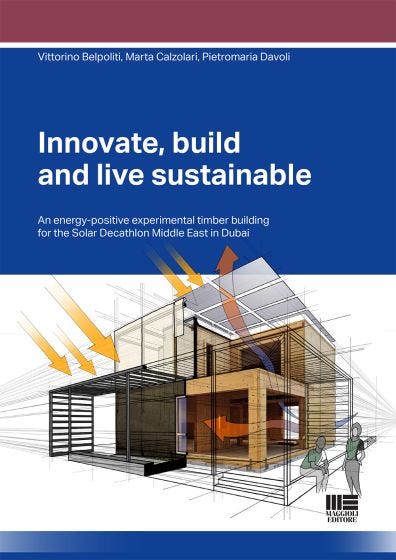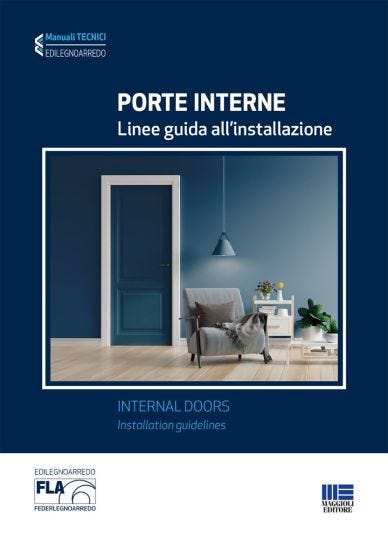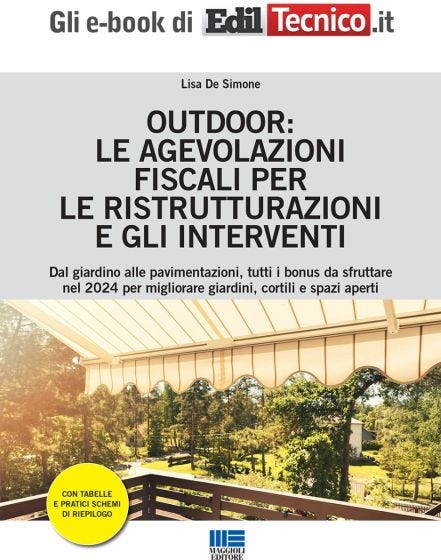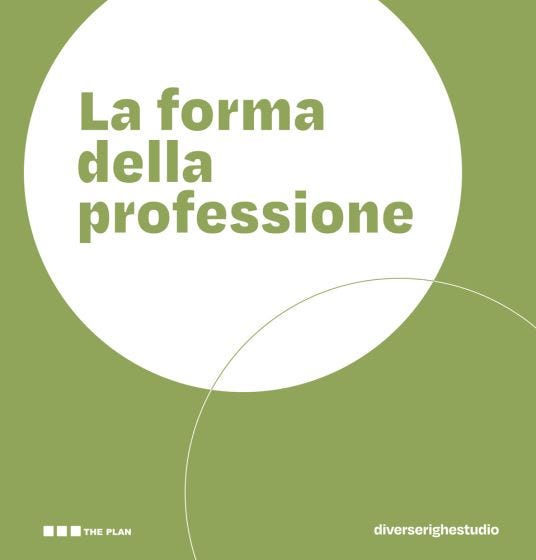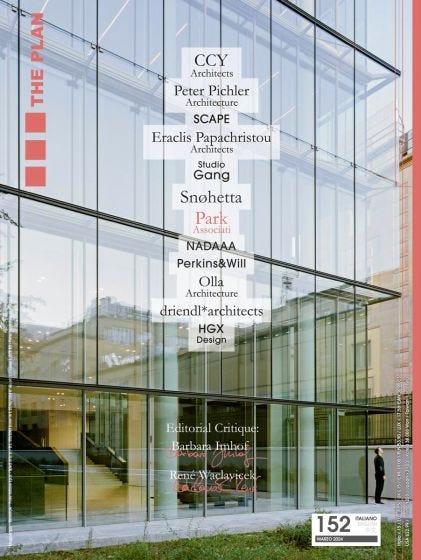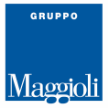Innovate, build and live sustainable
An energy-positive experimental timber building for the Solar Decathlon Middle East in Dubai
di Vittorino Belpoliti, Marta Calzolari, Pietromaria Davoli
To transform this great effort into an educational and enhancing opportunity, both from a teaching and research point of view, a post-event assessment is extremely necessary. In fact, during the two years of design and competition, it was impossible to pause the work to accurately process and scientifically codify the results.
After the project’s completion, the authors had the time for critical reading and interpretation of all the aspects of the event and decided that a book would be the most suitable space to collect and explain their findings.
This way makes it possible to convert the need for systematisation of all the related topics into the opportunity of dissemination inside and outside Academia.
The book presents the outcomes of a pilot project with the characters of a very scientific and rigorous experience thanks to an official and technical validation, which start from the design submissions, periodically evaluated during the whole project duration, to real on-site performance monitoring during the final contest period.
Additionally, the thorough scientific activity paid particular attention to the feasibility of the building process, aiming at real “buildability” and “operational functionality”, even though the team, as a whole, had no direct know-how of the construction sector, but only the direct experience of the individual members.
Such feasibility crucially required a balance to make sure the principles of high innovation and experimentation and the enthusiasm of the younger designers did not become an obstacle to the achievement of the first, but already difficult target: being ready at the kick-off of the contest period.
This means that the book, even if it does not present the winning project, has a structured frame of results due to the factual construction of the house and its scientific validation.
As a matter of fact, every SD experience and every team’s project is interesting and deserves to be documented, along with all the in-depth analysis and chosen strategies.
Furthermore, the book may become a useful resource also for those who intend to take part in future SDs all over the world, even if the uniqueness of every edition of the competition must be acknowledged.
This book intends to summarise both the contest routes and the design approach, to transform a training experience into a research project and vice versa.
Additionally, the described edition of SD was the first in the Middle East and the team considered it important to report this very first example of dissemination of the principles of sustainability in the chosen hosting country, the United Arab Emirates (UAE).
The opportunity of the contest, in the form of collaboration between academia and industry, played the role of vehicle of new design approaches and methods to build a less energy-demanding heritage, even in regions of the world that just recently embraced sustainable strategies, sometimes due to cultural and economic reasons that posed a strong barrier for the diffusion of energy efficiency measures.
The book introduces the KNOW HOWse1 project as one of the possible theoretical design methods of knowledge and technologies transferred from the European (and specifically Italian) know-how to the UAE, the receiving country as a representative for the Middle East.
For these reasons, the topic involves aspects related to:
• Architectural design, in a balance between local traditions and global innovation, involving the building shape, aesthetic/morphologic features, and house functioning.
• Technological research, with analysis about materials, envelope stratifications, and environmental active and passive strategies.
• Structural development to promote the export of innovative solutions and their adaptation to new environments.
• Economic strategies, mainly directed to the feasibility of the process and its access to new markets.
The project summarises a very complex experience, in which the heteronomy of the design phase helped to manage its interdisciplinary qualities in a mix of scientific research and teaching.
Technological and environmental design, the authors’ main field of expertise, is to be intended not as a “tool” to use after the conceptual design phase, but as a means to drive the process during the entire design and construction phases.
Moreover, this more adequate role of technological and environmental design is enhanced by the availability of digital tools and Key Enabling Technologies, which help in the prefiguration of the following impacts of the project.
They allow designers to calibrate the theoretical model for different aims and applications in diverse contexts and they can be adapted to different cultural stimuli and models.
The described experience also adds to the common design and construction sequence, the simulating and monitoring phase of the “as built” house, not only to assess the impact of the concept strategies, but also as an example of knowledge transfer for students and for professionals.
The book is structured in three parts.
The first describes the general background and the addressed topics (chapter 1) and provides the meaning and the objectives of the international competitions of the Solar Decathlon, with references to the Middle East edition, outlining objectives, actors, synergies, rules and the global market, representing the book’s framework (chapter 2).
The second part regards the KNOW HOWse project, specifically developed for the Solar Decathlon Middle East 2018 (SDME), with a description of the design objectives, innovation aspects, issues and the proposed Nearly Zero Energy Building strategies.
The project is described through the four chapters “Architectural approach and design”, “The Construction system”, “Environmental design and systems” and “Energy simulation and monitoring phase”.
The decision to divide the text in these four parts is a result of the attentive grouping of the ten sub-contests evaluated in the competition and from which the Decathlon takes its name.
The outlined four topics represent the main fields of experimentations within the SDME contest.
In chapter 3 “Architectural approach and design” typological, morphological, spatial, social, and cultural features are presented.
Chapter 4 “The Construction system” describes the new proposed structural design model, regarding the construction solutions chosen to enhance the off-site prefabrication of the building’s construction system.
It is a real “research into the research” because one of the main innovations of the KNOW HOWse project was precisely the development of a method to export a structural system to different countries.
Chapter 5 “Environmental design and systems” groups all the sustainable strategies to control the impact of the external environment and enhance the comfort level of the indoor spaces through a careful balance and a gentle synergy of passive and active systems.
The last Chapter of this part, number 6 “Energy simulation and monitoring phase”, reports the final phase of the competition, during which an instrumental monitoring of the house’s performances has been carried out to be compared with the energy simulation results.
Alongside the main Chapters of the book, two external contributions are included to deepen the technical issues of the project.
Specifically, the reader may focus on the description of the air conditioning and photovoltaic system (Technical focus 5.A and 5.B).
The third part is dedicated to the educational path: first thoughts are by the instructors, then the students’ point of view.
The two chapters of this section aim to describe one of the main aspects of the uniqueness of the SDME experience, which is characterised by the mix of scientific research and training activities.
Vittorino Belpoliti
Architect and Assistant Professor of Environmental Design at the Architectural Engineering Department, University of Sharjah, UAE. PhD in Energy Technologies, he teaches and investigates the topics of building construction, energy efficiency, and retrofit as researcher at the University of Ferrara, the Arkitektskole in Aarhus, Denmark, the University of California Berkeley, USA, the University of Nottingham, UK, the Indian Institute of Technology, Jodhpur India, and is author of numerous scientific papers. He was Project Manager for the participation of the University of Sharjah to the SDME 2018 and 2021 in Dubai, UAE.
Marta Calzolari
Architect and Assistant Professor in Architectural Technology, Department of Architecture (DA), University of Ferrara (Unife). Since 2009 she has been member of the Research Centre Architettura>Energia at the DA, Unife, working on the topics of sustainability, energy refurbishment of existing/historic buildings, and timber constructions. Participation in several research projects as “PRIN 2017 - TECH-START”, “HeLLo” H2020 - MSCA-IF-2017-EF, and the International Competition “Solar Decathlon Middle East 2018”. Member of the Academic Board of an international PhD program. She is the author of around 80 scientific publications.
Pietromaria Davoli
Full Professor in Architectural Technology, Department of Architecture (DA), University of Ferrara (Unife). Coordinator of the Master program in Architecture, DA. Director of the Architettura>Energia Research Centre, DA. Member of the Governing Council of the Italian Society of Technology of Architecture, the Editorial Board of the international Journal TECHNE, the Academic Board of international PhD programs, Unife. Participation in the Solar Decathlon Middle East 2018. Author of about 180 scientific publications. Main research on the relationships between climate, environment, architecture and sustainable technologies, also focusing on the historical heritage.
The participation in the Solar Decathlon (SD) was a very demanding, extremely hectic, and incredible experience.
To transform this great effort into an educational and enhancing opportunity, both from a teaching and research point of view, a post-event assessment is extremely necessary. In fact, during the two years of design and competition, it was impossible to pause the work to accurately process and scientifically codify the results.
After the project’s completion, the authors had the time for critical reading and interpretation of all the aspects of the event and decided that a book would be the most suitable space to collect and explain their findings.
This way makes it possible to convert the need for systematisation of all the related topics into the opportunity of dissemination inside and outside Academia.
The book presents the outcomes of a pilot project with the characters of a very scientific and rigorous experience thanks to an official and technical validation, which start from the design submissions, periodically evaluated during the whole project duration, to real on-site performance monitoring during the final contest period.
Additionally, the thorough scientific activity paid particular attention to the feasibility of the building process, aiming at real “buildability” and “operational functionality”, even though the team, as a whole, had no direct know-how of the construction sector, but only the direct experience of the individual members.
Such feasibility crucially required a balance to make sure the principles of high innovation and experimentation and the enthusiasm of the younger designers did not become an obstacle to the achievement of the first, but already difficult target: being ready at the kick-off of the contest period.
This means that the book, even if it does not present the winning project, has a structured frame of results due to the factual construction of the house and its scientific validation.
As a matter of fact, every SD experience and every team’s project is interesting and deserves to be documented, along with all the in-depth analysis and chosen strategies.
Furthermore, the book may become a useful resource also for those who intend to take part in future SDs all over the world, even if the uniqueness of every edition of the competition must be acknowledged.
This book intends to summarise both the contest routes and the design approach, to transform a training experience into a research project and vice versa.
Additionally, the described edition of SD was the first in the Middle East and the team considered it important to report this very first example of dissemination of the principles of sustainability in the chosen hosting country, the United Arab Emirates (UAE).
The opportunity of the contest, in the form of collaboration between academia and industry, played the role of vehicle of new design approaches and methods to build a less energy-demanding heritage, even in regions of the world that just recently embraced sustainable strategies, sometimes due to cultural and economic reasons that posed a strong barrier for the diffusion of energy efficiency measures.
The book introduces the KNOW HOWse1 project as one of the possible theoretical design methods of knowledge and technologies transferred from the European (and specifically Italian) know-how to the UAE, the receiving country as a representative for the Middle East.
For these reasons, the topic involves aspects related to:
• Architectural design, in a balance between local traditions and global innovation, involving the building shape, aesthetic/morphologic features, and house functioning.
• Technological research, with analysis about materials, envelope stratifications, and environmental active and passive strategies.
• Structural development to promote the export of innovative solutions and their adaptation to new environments.
• Economic strategies, mainly directed to the feasibility of the process and its access to new markets.
The project summarises a very complex experience, in which the heteronomy of the design phase helped to manage its interdisciplinary qualities in a mix of scientific research and teaching.
Technological and environmental design, the authors’ main field of expertise, is to be intended not as a “tool” to use after the conceptual design phase, but as a means to drive the process during the entire design and construction phases.
Moreover, this more adequate role of technological and environmental design is enhanced by the availability of digital tools and Key Enabling Technologies, which help in the prefiguration of the following impacts of the project.
They allow designers to calibrate the theoretical model for different aims and applications in diverse contexts and they can be adapted to different cultural stimuli and models.
The described experience also adds to the common design and construction sequence, the simulating and monitoring phase of the “as built” house, not only to assess the impact of the concept strategies, but also as an example of knowledge transfer for students and for professionals.
The book is structured in three parts.
The first describes the general background and the addressed topics (chapter 1) and provides the meaning and the objectives of the international competitions of the Solar Decathlon, with references to the Middle East edition, outlining objectives, actors, synergies, rules and the global market, representing the book’s framework (chapter 2).
The second part regards the KNOW HOWse project, specifically developed for the Solar Decathlon Middle East 2018 (SDME), with a description of the design objectives, innovation aspects, issues and the proposed Nearly Zero Energy Building strategies.
The project is described through the four chapters “Architectural approach and design”, “The Construction system”, “Environmental design and systems” and “Energy simulation and monitoring phase”.
The decision to divide the text in these four parts is a result of the attentive grouping of the ten sub-contests evaluated in the competition and from which the Decathlon takes its name.
The outlined four topics represent the main fields of experimentations within the SDME contest.
In chapter 3 “Architectural approach and design” typological, morphological, spatial, social, and cultural features are presented.
Chapter 4 “The Construction system” describes the new proposed structural design model, regarding the construction solutions chosen to enhance the off-site prefabrication of the building’s construction system.
It is a real “research into the research” because one of the main innovations of the KNOW HOWse project was precisely the development of a method to export a structural system to different countries.
Chapter 5 “Environmental design and systems” groups all the sustainable strategies to control the impact of the external environment and enhance the comfort level of the indoor spaces through a careful balance and a gentle synergy of passive and active systems.
The last Chapter of this part, number 6 “Energy simulation and monitoring phase”, reports the final phase of the competition, during which an instrumental monitoring of the house’s performances has been carried out to be compared with the energy simulation results.
Alongside the main Chapters of the book, two external contributions are included to deepen the technical issues of the project.
Specifically, the reader may focus on the description of the air conditioning and photovoltaic system (Technical focus 5.A and 5.B).
The third part is dedicated to the educational path: first thoughts are by the instructors, then the students’ point of view.
The two chapters of this section aim to describe one of the main aspects of the uniqueness of the SDME experience, which is characterised by the mix of scientific research and training activities.
Vittorino Belpoliti
Architect and Assistant Professor of Environmental Design at the Architectural Engineering Department, University of Sharjah, UAE. PhD in Energy Technologies, he teaches and investigates the topics of building construction, energy efficiency, and retrofit as researcher at the University of Ferrara, the Arkitektskole in Aarhus, Denmark, the University of California Berkeley, USA, the University of Nottingham, UK, the Indian Institute of Technology, Jodhpur India, and is author of numerous scientific papers. He was Project Manager for the participation of the University of Sharjah to the SDME 2018 and 2021 in Dubai, UAE.
Marta Calzolari
Architect and Assistant Professor in Architectural Technology, Department of Architecture (DA), University of Ferrara (Unife). Since 2009 she has been member of the Research Centre Architettura>Energia at the DA, Unife, working on the topics of sustainability, energy refurbishment of existing/historic buildings, and timber constructions. Participation in several research projects as “PRIN 2017 - TECH-START”, “HeLLo” H2020 - MSCA-IF-2017-EF, and the International Competition “Solar Decathlon Middle East 2018”. Member of the Academic Board of an international PhD program. She is the author of around 80 scientific publications.
Pietromaria Davoli
Full Professor in Architectural Technology, Department of Architecture (DA), University of Ferrara (Unife). Coordinator of the Master program in Architecture, DA. Director of the Architettura>Energia Research Centre, DA. Member of the Governing Council of the Italian Society of Technology of Architecture, the Editorial Board of the international Journal TECHNE, the Academic Board of international PhD programs, Unife. Participation in the Solar Decathlon Middle East 2018. Author of about 180 scientific publications. Main research on the relationships between climate, environment, architecture and sustainable technologies, also focusing on the historical heritage.
| Pagine | 195 |
| Data pubblicazione | Settembre 2022 |
| ISBN | 8891659453 |
| ean | 9788891659453 |
| Tipologia prodotto | Ebook |
| Sottotitolo | An energy-positive experimental timber building for the Solar Decathlon Middle East in Dubai |
| Collana | Ambiente Territorio Edilizia Urbanistica |
| Editore | Maggioli Editore |
Preface
Introduction
Sintesi dei contenuti
SECTION I
The international competition
Objectives, actors, synergies, and global market
1. Background for the development of an innovative construction model from tradition to innovation
2. Significance, visions, and opportunities of the Solar Decathlon international competition and the case-study of SDME
2.1. Filling the gaps in academic training by fostering collaboration with a construction industry that is oriented toward the concept of sustainable innovation
2.2. The Solar Decathlon international competition and its objectives
2.3. Birth, evolution, and dissemination of the SD
2.4. From meta-design to the contest: 2 years of design, 2 weeks of construction/assembly, and 2 weeks of juried-contest with performance monitoring and public visits
2.5. The scope of the design
2.6. The contest: from public attendance to the management of juries and monitoring
2.7. Dashboards and competition strategies
2.8. Sub-contests and tasks, with particular regards to the SDME
2.9. Funding of operations
2.10. Mutual interest between teams and stakeholders, and global effects
2.11. The specs of the SDME contest
2.12. The experience of Team KNOW HOWse – University of Sharjah, United Arab Emirates and University of Ferrara, Italy
SECTION II
The KNOW HOWse project
Objectives, innovations, issues, and nZEB strategies
3. Architectural approach and design
3.1. Social-urban approach: responding to the UAE context’s demand
3.2. Architectural Concept: combining tradition and innovation
3.3. Spatial experience and transition
3.4. Re-educating to tradition through flexibility
3.5. Interior Design
4. The construction system
4.1. Objectives of the construction design research
4.2. Application of the construction design to the KNOW HOWse
4.3. Construction materials for the KNOW HOWse
6 Table of contents
5. Environmental design and systems
5.1. Contest location, duration, and weather conditions
5.2. Orientation
5.3. Geometric features and orientation
5.4. Construction design for energy efficiency
5.5. Shading systems
5.6. The passive design to enhance natural ventilation and cooling
5.7. Smart and sustainable solutions for the MEP systems
5.7.1. An Innovative Air Conditioning system
5.7.2. MEP systems set-up for efficient disassembly-reassembly
5.7.3. The water-treatment system
5.7.4. The lighting system
5.7.5. Building automation
5.8. Solar photovoltaic system
5.8.1. System description
Technical Focus 5.A Solar cooling technologies – A case study of a hybrid solar air conditioning system used in the KNOW HOWse project
Technical Focus 5.B Overview of solar photovoltaics and parameter affecting its overall performance
6. Energy simulation and monitoring phase
6.1. Results of the energy performance simulation
6.1.1. Simulation scope and adopted tool
6.1.2. Simulation set up and data input
6.2. House performance simulation
6.2.1. Cooling loads
6.2.2. Internal gains
6.2.3. The building’s envelope performance
6.2.4. Energy performance during annual scenario and during the contest
6.3. Environmental performance simulation (testing scenarios)
6.4. PV system’s performance simulation
6.4.1. Technical features of the PV system
6.4.2. PV system simulation process and results
6.4.3. Energy balance forecast
6.5. Monitored house energy performance
6.5.1. Monitoring protocol
6.5.2. Cooling and lighting: readings and explanation of the monitored results
6.5.3. Monitored environmental performance
6.5.4. Monitored home appliances consumption
6.5.5. Summary of the simulated and monitored results for the house consumption
6.5.6. Monitored PV system performance
6.5.7. Measured energy balance
6.5.8. Preliminary energy payback analysis of the PV system
SECTION III
The KNOW HOWse project
The training experience and the point of view of the decathletes
7. Training experience
7.1. Added value in the training experience and professionalizing content
7.2. The delicate balance between the roles of students and instructors
7.3. Teaching sportsmanship and collaboration when competing between equals for the future of the Planet
7.4. Final remarks
8. Students’ experience
From the concept to the construction
Managing the construction process
Communication, dissemination, and sponsor networking
House exhibition during contest
The collegiate atmosphere and the cooperation between teams
9. Concluding remarks and lesson learnt
Team members and roles
References
Project Partners and Sponsors

